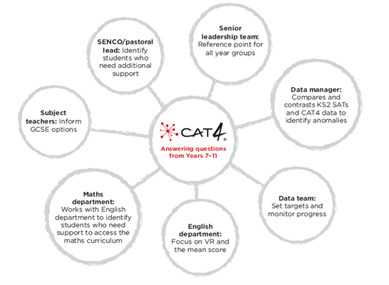10 Top Tips for CAT4
10 Top Tips for getting the best out of CAT4
It is important to remember that CAT4 is an indicator of potential, which if identified and supported correctly can lead to real change in attainment. Our Assessment Insights team is here to support you in maximising the insights available from your assessment data – read their top tips below for getting the best out of CAT4.
1 - Look beyond the mean score
CAT4 reports indicate strengths and challenges across four batteries (Verbal Reasoning, Non-verbal Reasoning, Spatial Reasoning and Quantitative Reasoning). Use conditional formatting within your Excel report to easily identify these – view our support video for advice on how to do this.
2 - Gain quick, in-depth insights into new cohorts at key transition points (e.g. Year 7)
Share this information with key department leads to explore your students’ curriculum strengths. Read our case study from St Peter’s Collegiate School to find out how they shared CAT4 data with staff.
3 - Look at individual battery scores in addition to the mean scores
Do not assume that students with average mean scores also have average scores in all batteries. An average ability mean score can often be overlooked; missing opportunities to develop areas of weakness and continue to challenge in areas of strength.
4 - Use the verbal/spatial profile to identify students’ reasoning strengths and weaknesses
Use the Strategies for Learning document (available in the Downloads section) to help support students with mild, moderate or extreme verbal/spatial profiles.
5 - Ensure that you are using the correct level for each year group
CAT4 has 10 available levels in the UK and 9 internationally – view our support page to check which level to use for each year group. Also ensure that student information on the paper data file or Testwise student upload form contains key group information (EAL, FSM, SEND, etc.)
6 - Use combination reports
From Level A onwards, use combination reports to compare potential from CAT4 and attainment from the Progress Test (PT) Series and New Group Reading Test (NGRT). These will help to identify students who may not be achieving their full academic potential relative to their reasoning ability. The GL Data Dashboard will also help you join up all your assessment results, so that they’re simple to access and easier to understand.
7 - Make CAT4 results accessible to all staff
Use our training videos to support subject leads in understanding the relevance of each reasoning battery on how these can influence a student’s performance across the curriculum.

8 - Use CAT4 with FFT's Transition Service
Access the full range of pupil, subject and school-based estimates for your Year 7 and Year 8 cohorts. The interactive Target Setting dashboard allows you to monitor progress and set aspirational targets.
9 - Use the indicators to inform target-setting
CAT4 provides a range of regularly updated indicators and national assessment points for KS2, GCSEs, A-levels and IB. These are available alongside UK and ROI regional indicators, such as the Leaving Certificate in Ireland.
10 - Book a data consultation
Book a free consultation with a member of our Assessment Insights team for support in gaining further insights into your CAT4 data. This guided analysis of your cohort data will help you to identify key groups of students to focus on, areas of the curriculum to reinforce and offer useful suggestions for next steps.

